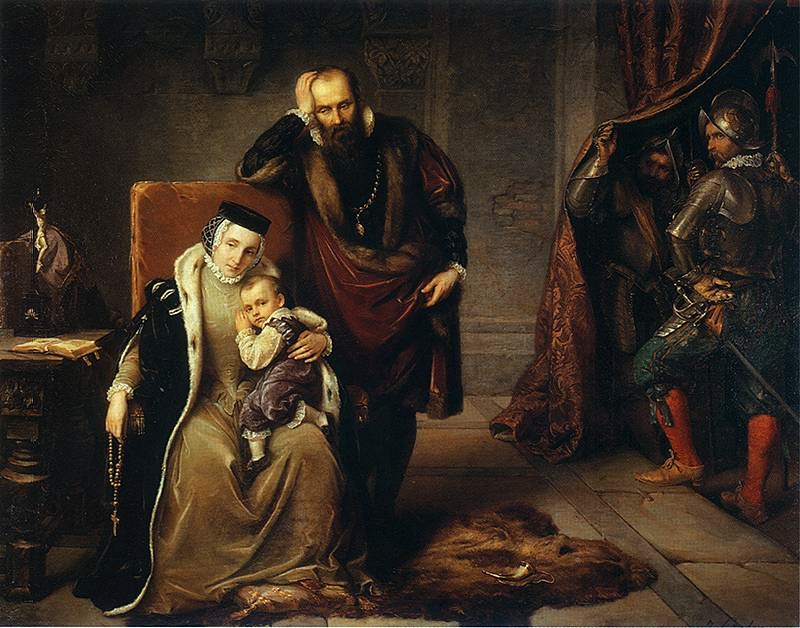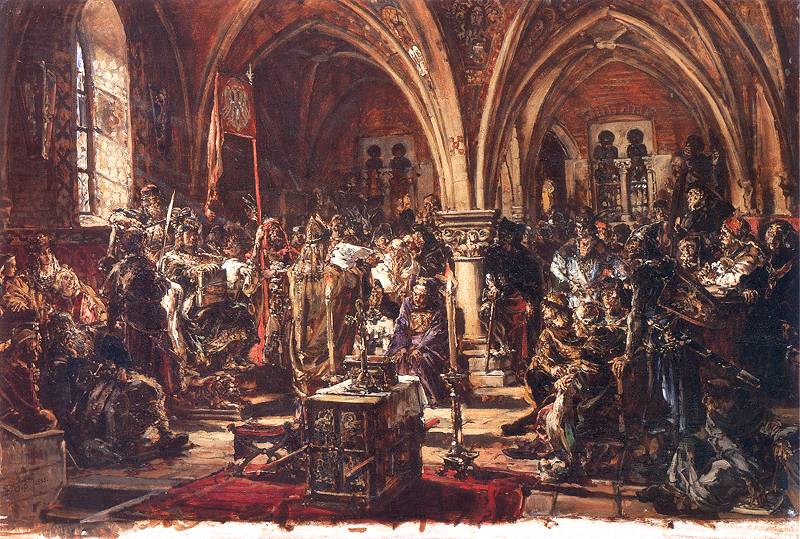|
Sejm Of The Polish–Lithuanian Commonwealth
The General Sejm (, ) was the bicameral legislature of the Polish–Lithuanian Commonwealth. It was established by the Union of Lublin in 1569 following the merger of the legislatures of the two states, the Sejm of the Kingdom of Poland and the Seimas of the Grand Duchy of Lithuania. It was one of the primary elements of the democratic governance in the Commonwealth (see Golden Liberty). The sejm was a powerful political institution. The king could not pass laws without its approval. The two chambers of a sejm were the Senate (''senat'') consisting of high ecclesiastical and secular officials, and the lower house, (''izba poselska''), the sejm proper, of lower ranking officials and the representatives of all szlachta. Together with the king, the three were known as the sejming estates, or estates of the sejm (''stany sejmujące'', literally, "deliberating estates"). Duration and frequencies of the sejms changed over time, with the six-week sejm session convened every two years ... [...More Info...] [...Related Items...] OR: [Wikipedia] [Google] [Baidu] |
House Of Vasa
The House of Vasa or Wasa was a Dynasty, royal house that was founded in 1523 in Sweden. Its members ruled the Kingdom of Sweden from 1523 to 1654 and the Polish–Lithuanian Commonwealth from 1587 to 1668. Its agnatic line became extinct with the death of King John II Casimir Vasa in 1672. The Vasa dynasty descended from a 14th-century Swedish noble family, tracing agnatic kinship to Nils Kettilsson (Vasa) (), the of Tre Kronor (castle), ''Tre Kronor'' Castle in Stockholm. Several members held high offices during the 15th century. In 1523, after the Stockholm Bloodbath, Stockholm bloodbath and the abolition of the Kalmar Union, Gustav Eriksson (Vasa) became King Gustav I of Sweden and the royal house was founded. His reign is sometimes referred to as the beginning of the modern Swedish state, which included the King's break with the Catholic Church during the Protestant Reformation and the foundation of the Church of Sweden. However, his eldest son and successor Erik XIV of Sw ... [...More Info...] [...Related Items...] OR: [Wikipedia] [Google] [Baidu] |
Bicameral
Bicameralism is a type of legislature that is divided into two separate Deliberative assembly, assemblies, chambers, or houses, known as a bicameral legislature. Bicameralism is distinguished from unicameralism, in which all members deliberate and vote as a single group. , roughly 40% of the world's national legislatures are bicameral, while unicameralism represents 60% nationally and much more at the subnational level. Often, the members of the two chambers are elected or selected by different methods, which vary from Jurisdiction (area), jurisdiction to jurisdiction. This can often lead to the two chambers having very different compositions of members. Enactment of a bill, Enactment of primary legislation often requires a concurrent majority—the approval of a majority of members in each of the chambers of the legislature. When this is the case, the legislature may be called an example of perfect bicameralism. However, in many parliamentary and semi-presidential systems, th ... [...More Info...] [...Related Items...] OR: [Wikipedia] [Google] [Baidu] |
Wiec Kazimierz Wielki
A ''veche'' was a popular assembly during the Middle Ages. The ''veche'' is mentioned during the times of Kievan Rus' and it later became a powerful institution in Russian cities such as Novgorod and Pskov, where the ''veche'' acquired great prominence and was broadly similar to the Norse ''thing'' or the Swiss ''Landsgemeinde''. The last ''veche'' meeting was held in Pskov before the institution was abolished in 1510. Etymology The word ''veche'' is a transliteration of the Russian (), which is in turn inherited from Proto-Slavic (), which is also represented in the word ''soviet'', both ultimately deriving from the Proto-Slavic verbal stem of ). History Origins Procopius of Caesarea mentioned Slavs gathering in popular assemblies in the 6th century: The ''veche'' is thought to have originated in the tribal assemblies of Eastern Europe, thus predating the state of Kievan Rus'. Although most authors have adopted this view, the evidence is not abundant and is mainly based o ... [...More Info...] [...Related Items...] OR: [Wikipedia] [Google] [Baidu] |
History Of The Czech Language
The Czech language developed at the close of the 1st millennium from common West Slavic. Until the early 20th century, it was known as ''Bohemian''. Early West Slavic Among the innovations in common West Slavic is the palatalization of velar ''ch'' > ''š'' (''vьšь'' 'all'), while ''s'' (''vьsь'') developed in the East and South Slavic dialects. Within West Slavic, Czech and Slovak separated from Polish around the 10th to 12th centuries. Some other changes took place during roughly the 10th century: * ''the disappearance and vocalization of yers'' according to Havlík’s Yer Law (''bъzъ > bez, bъza > bza'' ( gen.), later ''bezu'' 'elder, lilac'); * the contraction of groups ''vowel + j + vowel'' ( 'good'); * the ''denasalization'' of nasal ''ę'' ��> ''ä'' and ''ǫ'' �> ''u''. The disappearance of the odd yers strengthened the phonological contrast of palatalized (softened) and unpalatalized consonants, and resulted in alterations of epenthetic ''e'' and � ... [...More Info...] [...Related Items...] OR: [Wikipedia] [Google] [Baidu] |
Sejm
The Sejm (), officially known as the Sejm of the Republic of Poland (), is the lower house of the bicameralism, bicameral parliament of Poland. The Sejm has been the highest governing body of the Third Polish Republic since the Polish People's Republic, transition of government in 1989. Along with the upper house of parliament, the Senate of Poland, Senate, it forms the national legislature in Poland known as Parliament of Poland#National Assembly, National Assembly (). The Sejm comprises 460 Member of parliament, deputies (singular or ) elected every four years by Universal suffrage, universal ballot. The Sejm is presided over by a Speaker of parliament, speaker, the "Marshal of the Sejm" (). In the Kingdom of Poland (1385–1569), Kingdom of Poland, the term ''Sejm'' referred to an entire two-Chambers of parliament, chamber parliament, comprising the Chamber of Deputies (), the Senate and the King. It was thus a three-estate parliament. The 1573 Henrician Articles strengthe ... [...More Info...] [...Related Items...] OR: [Wikipedia] [Google] [Baidu] |
Interregnum
An interregnum (plural interregna or interregnums) is a period of revolutionary breach of legal continuity, discontinuity or "gap" in a government, organization, or social order. Archetypally, it was the period of time between the reign of one monarch and the next (coming from Latin ''inter-'', "between" and ''rēgnum'', "reign" [from ''rex, rēgis'', "king"]), and the concepts of interregnum and Regent, regency therefore overlap. Historically, longer and heavier interregna have been typically accompanied by widespread unrest, Civil war, civil and War of succession, succession wars between warlords, and power vacuums filled by foreign invasions or the emergence of a new power. The term also refers to the periods between the election of a new parliament and the establishment of a new government from that parliament in parliamentary democracies, usually ones that employ some form of proportional representation that allows small parties to elect significant numbers, requiring time f ... [...More Info...] [...Related Items...] OR: [Wikipedia] [Google] [Baidu] |
Royal Elections In Poland
Royal elections in Poland ( Polish: ''wolna elekcja'', lit. ''free election'') were the elections of individual kings, rather than dynasties, to the Polish throne. Based on traditions dating to the very beginning of the Polish statehood, strengthened during the Piast and Jagiellon dynasties, they reached their final form in the Polish–Lithuanian Commonwealth period between 1572 and 1791. The "free election" was abolished by the Constitution of 3 May 1791, which established a constitutional-parliamentary monarchy. Evolution The tradition of electing the country's ruler, which occurred either when there was no clear heir to the throne, or to confirm the heir's appointment, dates to the very beginning of Polish statehood. Legends survive of the 9th-century election of the legendary founder of the first Polish royal family, Piast the Wheelwright of the Piast dynasty, and similar voting of his son, Siemowit (that would place a Polish ruler's vote a century before the ear ... [...More Info...] [...Related Items...] OR: [Wikipedia] [Google] [Baidu] |
Liberum Veto
The ''liberum veto'' (Latin for "free veto") was a parliamentary device in the Polish–Lithuanian Commonwealth. It was a form of unanimity voting rule that allowed any member of the Sejm (legislature) to force an immediate end to the current session and to nullify any legislation that had already been passed at the session by shouting either ''Sisto activitatem!'' (Latin: "I stop the activity!") or ''Nie pozwalam!'' ( Polish: "I do not allow!"). The rule was in place from the mid-17th century to the late 18th century in the Sejm's parliamentary deliberations. It was based on the premise that since all of the Polish–Lithuanian noblemen were equal, every measure that came before the Sejm had to be passed unanimously. The ''liberum veto'' was a key part of the political system of the Commonwealth, strengthening democratic elements and checking royal power and went against the European-wide trend of having a strong executive ( absolute monarchy). Many historians hold that the '' ... [...More Info...] [...Related Items...] OR: [Wikipedia] [Google] [Baidu] |
Unanimous
Unanimity is agreement by all people in a given situation. Groups may consider unanimous decisions as a sign of social, political or procedural agreement, solidarity, and unity. Unanimity may be assumed explicitly after a unanimous vote or implicitly by a lack of objections. It does not necessarily mean uniformity and can sometimes be the opposite of majority in terms of outcomes. Voting Practice varies as to whether a vote can be considered unanimous if some voter abstains. In ''Robert's Rules of Order'', a "unanimous vote" is not specifically defined, although an abstention is not counted as a vote regardless of the voting threshold. Also in this book, action could be taken by "unanimous consent", or "general consent", if there are no objections raised. However, unanimous consent may not necessarily be the same as a unanimous vote (see Not the same as unanimous vote). In either case, it does not take into account the members who were not present. In contrast, a United Nati ... [...More Info...] [...Related Items...] OR: [Wikipedia] [Google] [Baidu] |
Majority Voting
In social choice theory, the majority rule (MR) is a social choice rule which says that, when comparing two options (such as bills or candidates), the option preferred by more than half of the voters (a ''majority'') should win. In political philosophy, the ''majority rule'' is one of two major competing notions of democracy. The most common alternative is given by the utilitarian rule (or other welfarist rules), which identify the spirit of liberal democracy with the equal consideration of interests.Ball, Terence and Antis Loizides"James Mill" The Stanford Encyclopedia of Philosophy (Winter 2020 Edition), Edward N. Zalta (ed.). Although the two rules can disagree in theory, political philosophers beginning with James Mill have argued the two can be reconciled in practice, with majority rule being a valid approximation to the utilitarian rule whenever voters share similarly-strong preferences. This position has found strong support in many social choice models, where the ... [...More Info...] [...Related Items...] OR: [Wikipedia] [Google] [Baidu] |
Szlachta
The ''szlachta'' (; ; ) were the nobility, noble estate of the realm in the Kingdom of Poland, the Grand Duchy of Lithuania, and the Polish–Lithuanian Commonwealth. Depending on the definition, they were either a warrior "caste" or a social class, and they dominated those states by exercising szlachta's privileges, political rights and power. Szlachta as a class differed significantly from the Feudalism, feudal nobility of Western Europe. The estate was officially abolished in 1921 by the March Constitution (Poland), March Constitution."Szlachta. Szlachta w Polsce" ''Encyklopedia PWN'' The origins of the ''szlachta'' are obscure and the subject of several theories. The ''szlachta'' secured Golden Liberty, substantial and increasing political power and rights throughout its history, begin ... [...More Info...] [...Related Items...] OR: [Wikipedia] [Google] [Baidu] |
Senate Of Poland
The Senate () is the upper house of the Parliament of Poland, Polish parliament, the lower house being the Sejm of the Republic of Poland, Sejm. The history of the Polish Senate stretches back over 500 years; it was one of the first constituent bodies of a bicameral parliament in Europe and existed without hiatus until the final Partitions of Poland, partition of the Polish state in 1795. The contemporary Senate is composed of 100 senators elected by a universal ballot and is headed by the Marshal of the Senate (''Marszałek Senatu''). The incumbent Marshal of the Senate is Małgorzata Kidawa-Błońska. Following a brief period of existence under the Second Polish Republic, the Senate was again abolished by the authorities of the Polish People's Republic. It was not re-established until the collapse of the communist government and reinstatement of democracy in Poland in 1989. The Senate is based in Warsaw and is located in a building which forms part of the Sejm Complex on Wiejs ... [...More Info...] [...Related Items...] OR: [Wikipedia] [Google] [Baidu] |





